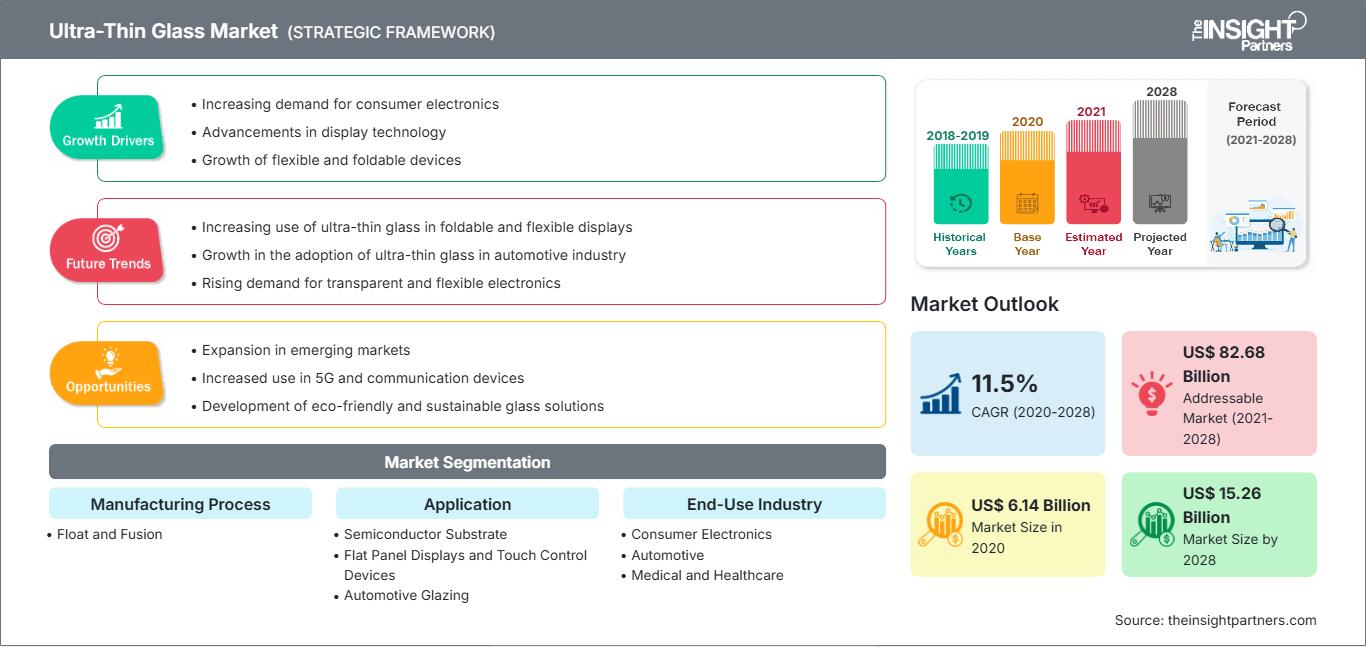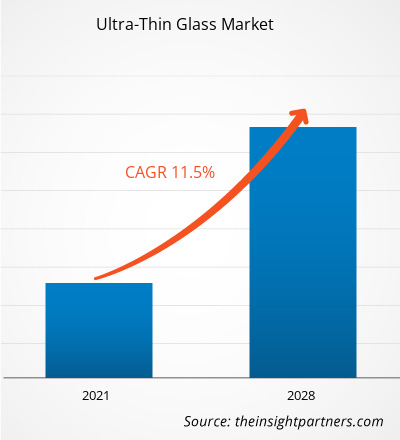[Rapporto di ricerca]Il mercato del vetro ultrasottile è stato valutato a 6.139,56 milioni di dollari nel 2020 e si prevede che raggiungerà i 15.264,74 milioni di dollari entro il 2028; si prevede una crescita a un CAGR dell'11,5% dal 2021 al 2028.
Il vetro ultrasottile è il vetro il cui spessore è inferiore a 1-2 mm.
Il rinforzo chimico tramite scambio ionico è comunemente utilizzato per rinforzare il vetro ultrasottile utilizzato per applicazioni high-tech.Il vetro ultrasottile temprato è resistente ai graffi e pieghevole fino a un raggio di pochi millimetri. Le proprietà del vetro ultrasottile, come la resistenza alla corrosione, la trasparenza, la flessibilità, l'eccellente barriera ai gas e all'acqua e l'elevata resistenza agli urti, lo rendono adatto a varie applicazioni come display a schermo piatto e vetri per autoveicoli, tra le altre. Nel 2020, l'area Asia-Pacifico ha detenuto la quota di fatturato maggiore del mercato globale del vetro ultrasottile. La Cina è il maggiore consumatore di vetri ultrasottili, con oltre il 50% della quota di mercato nell'area Asia-Pacifico. Il Paese è il principale polo produttivo per tutti i tipi di prodotti elettronici di consumo, come smartphone e LCD.L'attuale pandemia di COVID-19 ha drasticamente alterato lo stato del settore chimico e dei materiali e ha avuto un impatto negativo sulla crescita del mercato del vetro ultrasottile.
L'attuazione di misure per contrastare la diffusione del nuovo coronavirus ha aggravato la situazione e ha avuto un impatto negativo sulla crescita di diversi settori. Settori come l'automotive e l'elettronica di consumo hanno subito l'impatto negativo dell'improvvisa distorsione dell'efficienza operativa e delle interruzioni nelle catene del valore dovute alla chiusura improvvisa dei confini nazionali e internazionali. Il calo della crescita di diversi settori ha avuto un impatto negativo sulla domanda di vetro ultrasottile nel mercato globale. Tuttavia, poiché le economie stanno pianificando di rilanciare le proprie attività, si prevede che la domanda di vetro ultrasottile aumenterà a livello globale nei prossimi anni. A causa della pandemia, l'adozione di una cultura del lavoro a distanza e della formazione online è in crescita. Di conseguenza, la domanda di prodotti come laptop, smartphone e altri dispositivi di telecomunicazione è in crescita. Si prevede che la crescente domanda di vetro ultrasottile in vari settori, come l'automotive e l'elettronica di consumo, insieme ai significativi investimenti da parte di importanti produttori, guiderà la crescita del mercato del vetro ultrasottile durante il periodo di previsione.Personalizza questo rapporto in base alle tue esigenze
Potrai personalizzare gratuitamente qualsiasi rapporto, comprese parti di questo rapporto, o analisi a livello di paese, pacchetto dati Excel, oltre a usufruire di grandi offerte e sconti per start-up e università
Mercato del vetro ultrasottile: Approfondimenti strategici

-
Ottieni le principali tendenze chiave del mercato di questo rapporto.Questo campione GRATUITO includerà l'analisi dei dati, che vanno dalle tendenze di mercato alle stime e alle previsioni.
Approfondimenti sul settore di utilizzo finale
Nel 2020, il segmento dell'elettronica di consumo ha detenuto la quota maggiore del mercato globale del vetro ultrasottile. Il vetro ultrasottile è ampiamente utilizzato nella produzione di prodotti elettronici, come display a schermo piatto e touch screen per vari dispositivi, come LCD, OLED, smartphone e dispositivi indossabili. Con la crescente domanda di prodotti elettronici innovativi e tecnologicamente avanzati in tutto il mondo, si prevede che la domanda di vetri ultrasottili aumenterà nei prossimi anni.
Approfondimenti sul processo di produzione
In base al processo di produzione, il segmento della fusione ha dominato il mercato del vetro ultrasottile in termini di fatturato nel 2020. Il processo di fusione, spesso noto come metodo di overflow downdraw, è ampiamente utilizzato per produrre vetri ultrasottili piatti per pannelli di visualizzazione. Corning è stata la prima azienda a creare un vetro speciale sospeso a mezz'aria, caratteristica fondamentale del metodo di fusione. Il vetro non entra in contatto con il metallo fuso, il che rappresenta un vantaggio fondamentale del metodo di fusione rispetto al metodo del vetro float.
Alcuni dei principali attori del mercato del vetro ultrasottile sono Corning Incorporated; AGC Inc.; Nippon Electric Glass Co., Ltd.; SCHOTT AG; Central Glass Co., Ltd.; CSG Holding Co., Ltd.; Emerge Glass; Nippon Sheet Glass Co., Ltd; Xinyi Glass Holdings Limited; e Luoyang Glass Co., Ltd. I principali attori del mercato stanno adottando strategie come fusioni e acquisizioni e lanci di prodotti per espandere la propria presenza geografica e la propria base di consumatori.
Mercato del vetro ultrasottileLe tendenze regionali e i fattori che influenzano il mercato del vetro ultrasottile durante il periodo di previsione sono stati ampiamente spiegati dagli analisti di The Insight Partners. Questa sezione illustra anche i segmenti e la geografia del mercato del vetro ultrasottile in Nord America, Europa, Asia-Pacifico, Medio Oriente e Africa, America Meridionale e Centrale.
Ambito del rapporto sul mercato del vetro ultrasottile
| Attributo del rapporto | Dettagli |
|---|---|
| Dimensioni del mercato in 2020 | US$ 6.14 Billion |
| Dimensioni del mercato per 2028 | US$ 15.26 Billion |
| CAGR globale (2020 - 2028) | 11.5% |
| Dati storici | 2018-2019 |
| Periodo di previsione | 2021-2028 |
| Segmenti coperti |
By Processo di produzione
|
| Regioni e paesi coperti |
Nord America
|
| Leader di mercato e profili aziendali chiave |
|
Densità degli attori del mercato del vetro ultrasottile: comprendere il suo impatto sulle dinamiche aziendali
Il mercato del vetro ultrasottile è in rapida crescita, trainato dalla crescente domanda degli utenti finali, dovuta a fattori quali l'evoluzione delle preferenze dei consumatori, i progressi tecnologici e una maggiore consapevolezza dei vantaggi del prodotto. Con l'aumento della domanda, le aziende stanno ampliando la propria offerta, innovando per soddisfare le esigenze dei consumatori e sfruttando le tendenze emergenti, alimentando ulteriormente la crescita del mercato.

- Ottieni il Mercato del vetro ultrasottile Panoramica dei principali attori chiave
- Tendenze progressive nel settore del vetro ultrasottile per aiutare gli operatori a sviluppare strategie efficaci a lungo termine
- Strategie di crescita aziendale adottate dalle aziende per garantire la crescita nei mercati sviluppati e in via di sviluppo
- Analisi quantitativa del mercato globale del vetro ultrasottile dal 2019 al 2028
- Stima della domanda di vetro ultrasottile in vari settori
- Analisi di Porter per illustrare l'efficacia di acquirenti e fornitori che operano nel settore per prevedere la crescita del mercato
- Sviluppi recenti per comprendere lo scenario competitivo del mercato e la domanda di vetro ultrasottile
- Tendenze e prospettive di mercato insieme ai fattori che guidano e frenano la crescita del mercato del vetro ultrasottile
- Comprensione delle strategie che sostengono l'interesse commerciale per quanto riguarda la crescita del mercato globale del vetro ultrasottile, aiutando nel processo decisionale
- Dimensioni del mercato del vetro ultrasottile in vari nodi di mercato
- Panoramica dettagliata e segmentazione del mercato globale del vetro ultrasottile e delle sue dinamiche di settore
- Dimensioni del mercato del vetro ultrasottile in varie regioni con promettenti opportunità di crescita
Mercato del vetro ultrasottile, per processo di produzione
- Float
- Fusione
Mercato del vetro ultrasottile, per applicazione
- Substrato semiconduttore
- Display a schermo piatto e dispositivi di controllo touch
- Vetri per autoveicoli
- Altri
Mercato del vetro ultrasottile, per settore di utilizzo finale
- Elettronica di consumo
- Automotive
- Medicina e assistenza sanitaria
- Altri
Profili aziendali
- Corning Incorporata
- AGC Inc.
- Nippon Electric Glass Co., Ltd.
- SCHOTT AG
- Central Glass Co., Ltd.
- CSG Holding Co., Ltd.
- Emerge Glass
- Nippon Sheet Glass Co., Ltd
- Xinyi Glass Holdings Limited
- Luoyang Glass Co., Ltd
- Analisi storica (2 anni), anno base, previsione (7 anni) con CAGR
- Analisi PEST e SWOT
- Valore/volume delle dimensioni del mercato - Globale, Regionale, Nazionale
- Industria e panorama competitivo
- Set di dati Excel
Report recenti
Rapporti correlati
Testimonianze
Motivo dell'acquisto
- Processo decisionale informato
- Comprensione delle dinamiche di mercato
- Analisi competitiva
- Analisi dei clienti
- Previsioni di mercato
- Mitigazione del rischio
- Pianificazione strategica
- Giustificazione degli investimenti
- Identificazione dei mercati emergenti
- Miglioramento delle strategie di marketing
- Aumento dell'efficienza operativa
- Allineamento alle tendenze normative






















 Ottieni un campione gratuito per - Mercato del vetro ultrasottile
Ottieni un campione gratuito per - Mercato del vetro ultrasottile